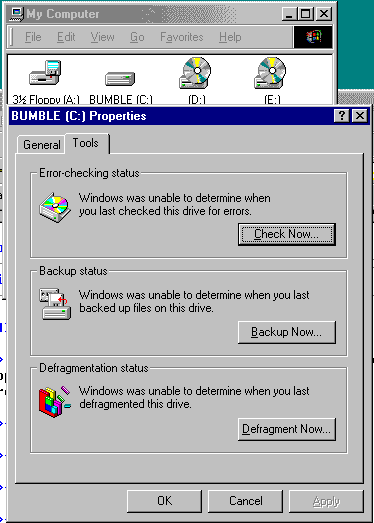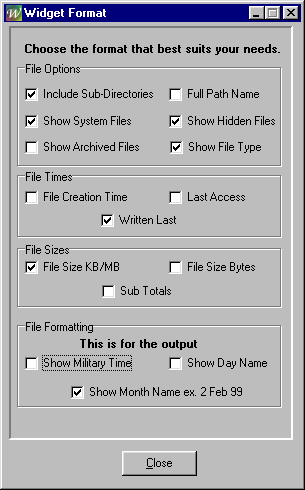Back up Your Files
Why?
Computers are great, but sometimes things go wrong. A hard drive failure isn't a common thing, but it can happen—and it's always unexpected. Maybe you can get a professional to recover your data, but maybe not.
It's also possible to have such a serious problem that you have no choice but to reformat your hard drive and start over with a clean install of Windows.
One day you may buy a new machine, or just have your present one upgraded. Data can be lost during upgrades, and of course a new machine is a blank page.
In any of these cases, it takes time to get things back the way you had them. If you've been making regular and frequent backups, it's a bit easier and a bit faster. You don't need to try to remember nearly as much, and very little is lost.

If you open My Computer, right click on the C drive, choose Properties from the menu, and then click on Tools, you'll see three things offered.
The first and third are essential; the middle one, in my opinion, isn't worth the pixels it's printed on. My reason for saying this is that recovering data backed up this way works only under certain conditions, and surely you want to have your work saved so that you can recover it in any circumstances, foreseen or not.
I met a man who'd faithfully backed up this way while using Windows 95. Now, with a new machine running XP Pro, he wants to read the saved data. Nothing doing! Windows says it can't read the files. He's now getting an old machine up and running with Windows 95, and he'll probably get his work back that way. I hope so.
Do It Your Own Way and Be Sure
Just how thoroughly you should back something up depends on its value to you. A program that you've downloaded once may take a long time to download a second time. A story or other document that you've written is unique; you can't get it from anywhere else, ever. I'd therefore pay closest attention to your own work.
Floppy Disks
You can save many small files onto a floppy disk. Just how many depends on format—text files are tiny, word processor files are usually much bigger. There's even a “Send to Floppy Disk” item on the right click Send To menu.
I've heard people complain that floppies aren't always reliable. This may be so, although I've had no failures in ten years. It may be wise to make two separate ones, just in case—and store them carefully. Heat, dampness, and above all, magnetism, can ruin a floppy disk in short order. Computer speakers and telephones contain magnets. A floppy left leaning on either will almost certainly be ruined.
Label the floppy as soon as you've made it. Include the date and either file names or enough description to identify it.
Compact Discs
You can put many files onto a CD. Depending on the burning program you have, you should be able to add more files on subsequent occasions. Some programs even make it easy for you to drag and drop files onto a CD.
Files recorded straight onto a CD usually become “Read Only”—they cannot be altered, even after copying back onto a hard disk, unless you remove the read only attribute. This may be a good thing; you can open the file, “Save As” under a slightly different name and finish up with your original as well as your editable copy.

Label the CD as soon as you've made it. Include the date and either file names or enough description to identify it. If there are lots of files, print out a list and fold it small enough to fit into the CD case. Have a name and date on both the CD and the list.
WidgetPrint is a nice small program that will list all the files in a directory. You can choose which details you want to include—size, date, whatever. You open the program, make sure that the options are as you want them, then, from File > Open, point it to the folder (in this case the CD) whose files you want to list.
Of course you could copy the list and paste it into a desktop publishing program and make an attractive-looking leaflet. Takes some time, though.
Removing the Read Only Attribute
If you want to remove the Read Only attribute from a single file, right click, choose Properties, and click in the square where you see a black tick beside Read Only. When the tick has gone, click OK.
To remove the Read Only attribute from a lot of files at once, select them all, but be sure that they all have the same extension—for instance, they all have doc after their name, or they all have txt after their name.
In a crowded folder, it's easiest to select files of the same kind if you choose View > List and View > Arrange Icons > by Type. Then you have only to click on the first one, hold the shift key and click on the last one.
To remove the Read Only from all of the selected files in one go, right click on one of them, click Properties, and remove the tick from the Read Only square. Click OK.
Zip
Zipping has at least two advantages: it makes files considerably smaller, and it preserves their attributes. Files extracted from a zip won't be Read Only unless they were that way before you zipped them up—even if the zip is saved onto a CD.
I had been using Freezipper, 839 kilobytes, which seems to be quite similar to WinZip, but its download site isn't available right now. You could Google for it; it may be back when you read this. Meanwhile, I've tried some other free zip programs.
EasyZip has an extensive tutorial and some useful advanced features. If you're unfamiliar with zipping, this might be a good choice. It's about 5 Megabytes.
JustZIPit doesn't use an interface—you simply choose JustZIPit - Create a zip file - from your right click menu and a zip is created with the name of the folder or file that you clicked on. Unzipping is equally simple. I like this one very much, because it does exactly what I want without giving me the opportunity to tick the wrong choices—and it's very quick to use. It's 373 kilobytes, a nice fast download.
Vallen Zip is only 854 kilobytes and has the same sort of interface as WinZip but unfortunately has no help.
WinZip is tried, trusted and always available, but it's shareware, not freeware. WinZip is 3.9 megabytes.
Zipping Folders within Folders
If you're zipping a folder that has other folders within it, make sure that the subfolders are preserved. Until you're sure, make a new folder, put the zip file inside it and unzip, then check that the extracted folder is arranged in the same way as the original. If everything's correct, pull the zip file out of the folder and then send the test folder to the recycle bin.
If the unzipped folder is different from the original, dump the test folder, zip and all, and try again with slightly different options.
Have some sort of storage for hard copies of things you write, for the important addresses in your email address book and odds and ends like serial numbers. Expanding files don't take up much space, and they hold a lot of copy. It doesn't need to be beautifully formatted—it's the words (or numbers or equations) that matter. It's much easier to scan—or even type—back from a printed page than to rack your brain trying to put the whole thing together again.
What to Back Up
Your Own Work
The most important things to back up are the things you've written or made yourself. Photographs, drawings, stories essays and poems, your financial ins and outs, (but see the note below) maybe even your thesis. It's better to make a sloppy back up today than to wait until you have time to organise everything beautifully.
Serial Numbers
If you download a program and pay to register it, print out the email that's sent to you on registration. Most software manufacturers will find your product key, customer number or serial number for you if you ask, but it can take time—and it's embarrassing! It isn't a bad idea to have one long list on one sheet of paper. Makes things much easier if you have to set up all over again.
Address Book
Keep a list of important email addresses that you can read and copy yourself.
Downloaded SetUp Files
Sometimes they're big and take a long time to download. Sometimes they cease to be available. It's a very good idea to put them onto a CD ready for next time.
Oh, this is worth remembering, too. Before you put a setup file onto a CD, put it into a folder with a name that means something to you. Do you call that program Jasc, or do you call it PSP, zls or Zone Alarm, jpsetup or Vallen JPegger?
Whole Programs
Some programs, particularly free downloads and old DOS programs, keep all of their files neatly together in one folder, without using the registry and without saving files in Application Data or anywhere else.
Very often, such programs can be zipped up as is and put onto a CD. After the crash, or when you buy the new computer or whatever, they can be unzipped, complete with the preferences you've set and any files they saved in their own directory. They must be zipped, though. Save the setup file as well, in case it doesn't work!
What Not to Record in an Obvious Way
Like computer crashes, burglaries are uncommon and unexpected. Should it happen, though, you don't want to give the intruder a way into your bank account or a way to borrow your identity.
All the really important personal stuff needs to be well out of the way.
If you carry out any financial transactions on line, don't record passwords or any other details on or near your computer. Because I don't have a credit card or do on line banking, I've not had to work out a solution for this one. I keep my spare door key in my neighbours' house. I'd probably do something similar with sensitive computer stuff. Back to "What to back up".
OK. I think that's backing up covered—although I'm bound to've forgotten something! It's so easy to forget a couple of things when doing it all at once. That's why we should back up regularly and often—every time we put something new onto a computer!
Questions or comments? I’d love to hear from you. My email address is here.
Return to top
Drop-Down Menu from Brothercake
Everything below this is a javascript menu. If you are using a reader,
please use the links here.